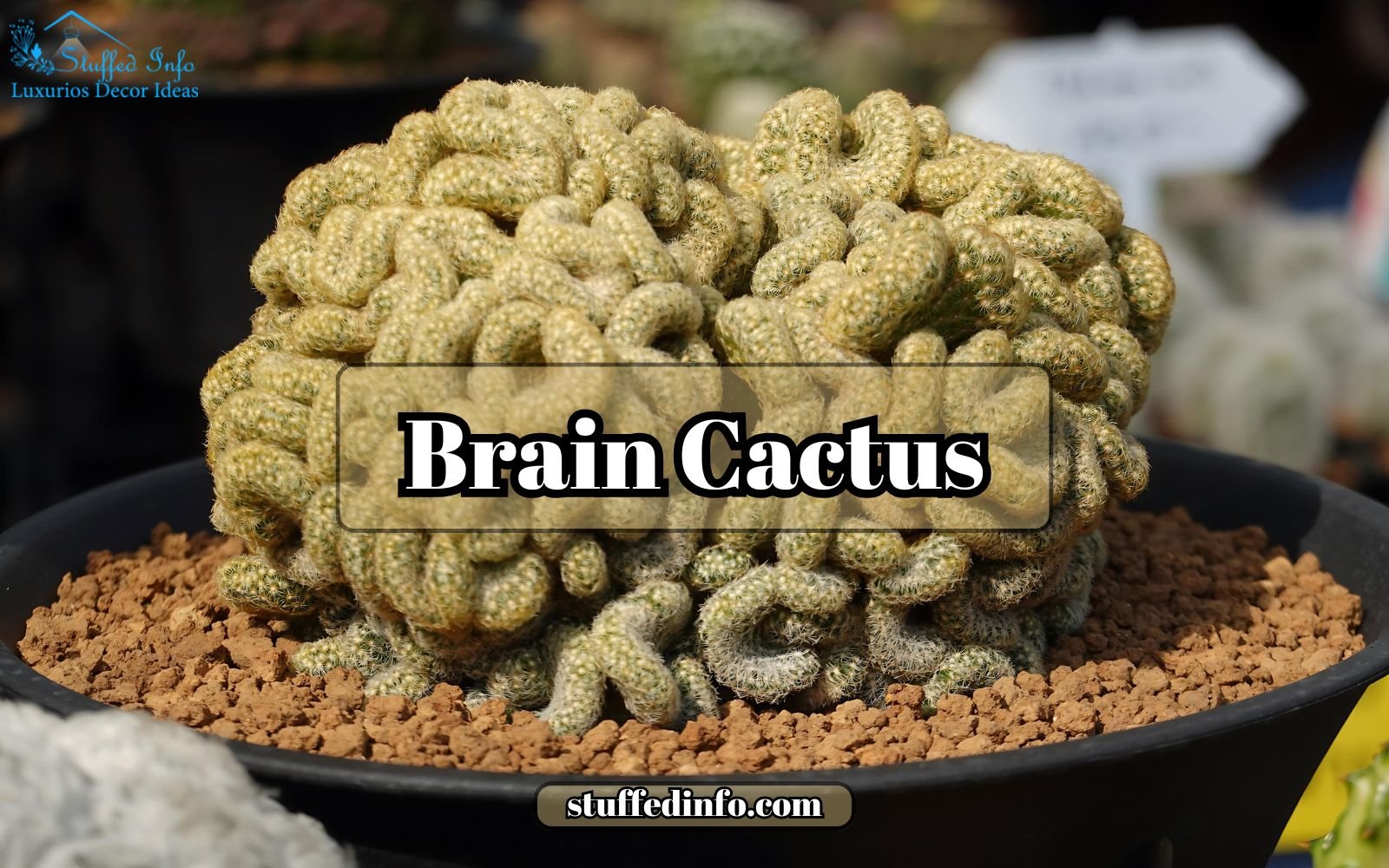The brain cactus is a unique plant that looks like the inner brain’s structure. It is no surprise that many plant enthusiasts desire this plant due to its attractive shape and highly vivid color. The brain cactus is fondly sought after among gardeners because it is indigenous to Mexico, has a robust build, and a compact size.
But the main question is how to grow and care for the cactus. Don’t worry, this guide contains all the answers related to your questions including the causes of its appearance and the measures to eliminate the potential factors that could harm the health of your cactus. So, without any further ado, let’s dive into the main section.
Table of Contents
ToggleWhat is a Brain Cactus?
There is a species of cactus known for its small cylindrical stem and it’s known as the brain cactus. The brain effect comes from the mutation known as cristation, it will lead to growing cactus in a wavy pattern. Thus, the mutation will provide a twisted, wavy, and compact appearance that resembles the human brain.
The surface of this cactus is basically covered with the soft spines that range from whité to golden and it will provide a delicate yet striking look. This plant is relatively easy to care for because it is of low maintenance to any succulent collection and it may look intricate. So cute because of its slow growth it’s more expensive as compared to other ones.
How to Grow and Care for Brain Cactus?
Caring for the cactus is crucial and it requires a deep understanding of the natural environment. But the question is how to care for the brain cactus. This plant grows best in environments that are similar to their natural habitat. Here are some points which are essential for cactus care:
Light Requirements
This cactus prefers bright, indirect light and can tolerate full sun, especially outdoors. When growing indoors, place it near a south- or east-facing window to give it adequate light. Overexposure to direct sunlight, however, can cause sunburn, so keep an eye on its exposure.
Watering
As a drought-tolerant plant, the cactus does not require frequent watering. In the growing season (spring and summer), water it roughly every 2–3 weeks, and reduce watering to once a month during fall and winter.
Soil Requirements
Soil is an essential requirement for any plant to grow. Thrives in well-draining soil. A cactus or succulent potting mix is ideal, as it prevents water from pooling around the roots. If you’re creating a custom mix, combine regular potting soil with sand, perlite, or pumice for proper drainage.
Temperature and Humidity
In order to grow a cactus it requires a warm, dry place. Typically, people consider 70°F–80°F (21°C–27°C) an ideal temperature for cactus growth. Also, make sure to avoid frost temperature as it can damage the plant. Also, a low-humidity climate can be considered as an ideal temperature.
Fertilization
Usage of fertilizers can be a good option for the growth of cacti. One can feed the cactus easily but remember there are chances where fertilizers can create a negative impact on plants. During the growing season, use a diluted cactus fertilizer and it should be used once a month. Try to skip fertilizing in the fall and winter seasons, as the cactus is dormant and does not require nutrients.
Propagating Brain Cactus
There are different options for growing a brain cacti. One can either purchase an established plant or cultivate it. While brain cacti cultivation is possible, it can be challenging due to its unique growth pattern. Here are some options one can use to grow a cactus:
Propagation by Cuttings: The most common method is cultivating through cuttings. Cut a healthy stem and let it grow for a few days. After that, place it in well-draining soil. Usually within a few weeks it will start growing. Be patient, as this cactus is a slow grower.
Propagation by Seeds: You can also grow a brain cactus from seeds. However, it requires time and specific conditions. Sow the seeds in a cactus mix and then lightly cover them with soil. Germination may take several weeks, and even then, growth is very slow.
Potting: Another method is potting, one can use a small, shallow pot with drainage holes, as the brain cactus has a compact root system. Consider terracotta pots the best option for this purpose, as they allow excess moisture to evaporate and reduce the risk to the roots.
Common Pests and Plant Diseases
Brain cactus may face problems from pests such as mealybugs, fungus gnats and scale insects, as well as diseases such as root rot caused by too much water. Recognizing problems early and treating them immediately helps save the plant.
Mealybugs: These small white insects hide in plant cracks, thorns, or in the soil. They spread quickly and are difficult to remove.
Root rot: This disease often occurs due to excessive watering. Symptoms include soft stems and roots, wet soil and a dry up appearance. Once affected the plant is difficult to save.
Fungus Gnats: These small flying insects prefer moist soil and lay eggs in cactus pots. Their larvae damage the roots by eating them.
Scale insects: These look like small, oval bumps on cactus. They make the plant sticky by secreting honey. Use insecticidal soap to clean them.
By regularly inspecting your brain cactus and addressing problems in time, you can keep it healthy and thriving. Proper care and timely treatment are important to prevent damage to your plant from pests and diseases.
Common Problems With Brain Cactus
The Brain Cactus (Mammillaria elongata ‘Cristata’) is a charming succulent known for its twisted and brain-like growth pattern. While relatively low-maintenance it can encounter some common problems. Here is a list of issues and how to address them:
Overwatering
- Symptoms: Yellowing, mushy stems and root rot.
- Solution: Allow the soil to dry completely between waterings. Use well-draining cactus soil and pots with drainage holes.
Underwatering
- Symptoms: Shriveling and wrinkled stems.
- Solution: Water thoroughly when the soil is completely dry especially during the growing season (spring and summer). Reduce watering in the winter.
Insufficient Light
- Symptoms: Leggy growth, pale coloration and deformation.
- Solution: Provide bright, indirect sunlight or direct morning sun. If indoors, place near a sunny window or use a grow light.
Excessive Sunlight
- Symptoms: Sunburn, brown or white patches on the cactus.
- Solution: Gradually adjust the plant to intense sunlight. Provide some shade during the hottest parts of the day.
Temperature Stress
- Symptoms: Stunted growth or discoloration due to cold or heat.
- Solution: Maintain temperatures between 50°F and 80°F (10°C–27°C). Protect from frost and avoid placing near heating vents.
Fungal Infections
- Symptoms: Black or brown spots, soft patches and drain areas.
- Solution: Remove infected areas with a sterilized knife. Allow the cuts to be callous before replanting. Improve air circulation around the plant.
Poor Soil Drainage
- Symptoms: Stay wetness in soil leading to root issues.
- Solution: Use a cactus-specific soil mix and ensure proper drainage in the pot.
By following these common issues with proper care, the Brain Cactus can thrive and remain a unique and eye-catching addition to your plant collection. Keep an eye on its water, light, and soil needs. It will reward you with its fascinating “brain-like” beauty.
Conclusion
The brain cactus is a beautiful and unique plant, offering an intriguing addition to any home or garden. Though it has an unusual appearance, it becomes surprisingly resilient with proper care. But people get confused and don’t know how to care for cactus. With minimal watering, bright light, and well-draining soil, this cactus can thrive indoors or outdoors and reward you with its mesmerizing, twisted form for years.
Whether you’re a seasoned cactus grower or new to the succulent world, the cactus is a conversation starter and an excellent plant to cultivate. Its low-maintenance requirements make it a delightful addition for anyone looking to add some intrigue to their plant collection.
Frequently Asked Questions
Where is the brain cactus native?
The cactus is native to the arid, rocky region of central Mexico, where the condition of weather is commonly dry and sunny.
Does the cactus need fertilization?
Yes, you can fertilize the cactus during the growing season with diluted, balanced cactus fertilizers every 4-6 weeks. Avoid fertilizing in the rainfall and winter season.
What are the common problems should I watch out for with a Brain Cactus?
Common issues include root rot from overwatering, pests like mealybugs or spider mites, and sunburn if exposed to intense, direct sunlight for prolonged periods without acclimation.







